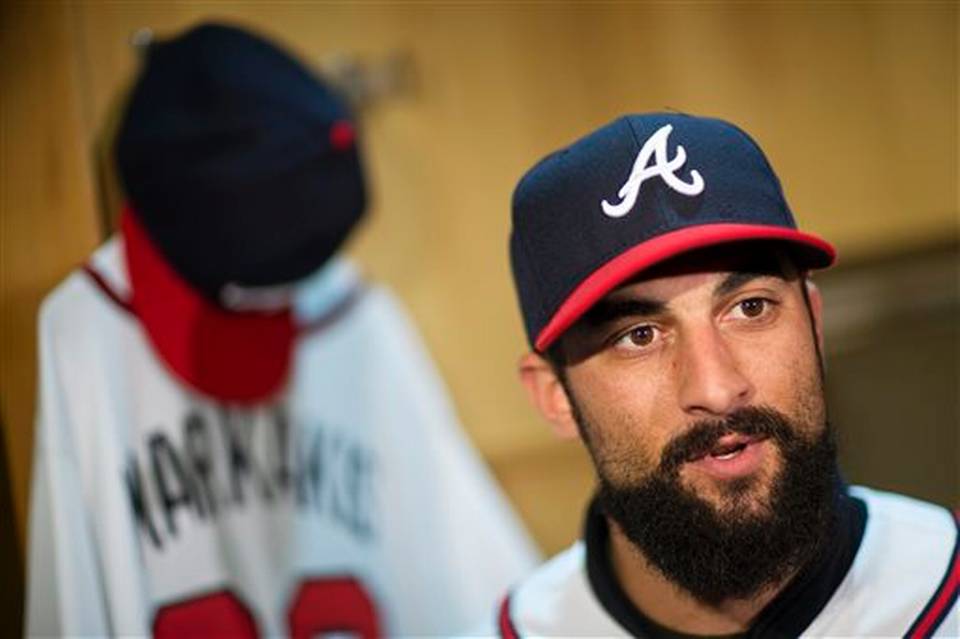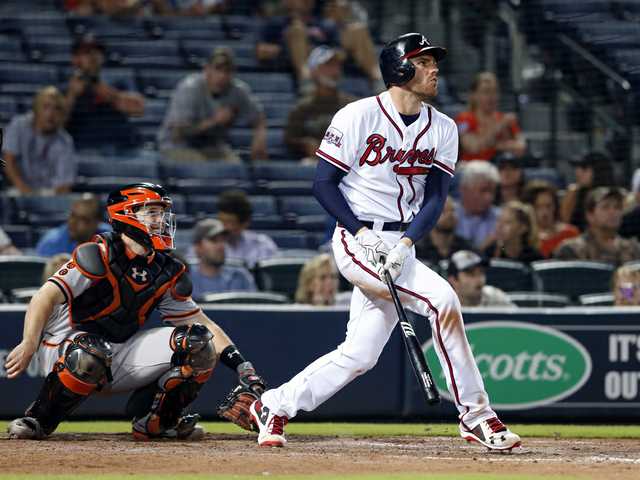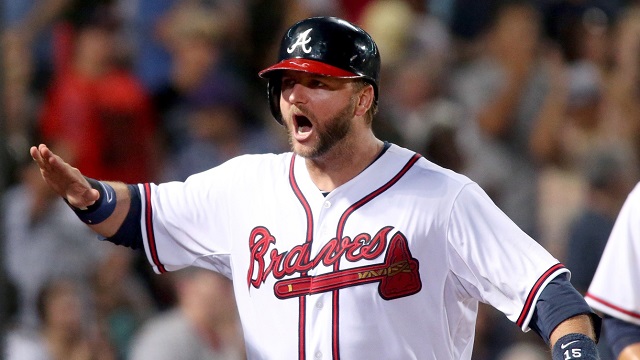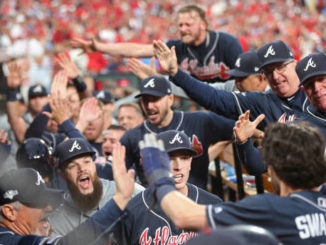Earlier this week, I wrote about what Julio Teheran’s trade value should be, or at least what Atlanta should determine it to be. Julio is obviously Atlanta’s biggest trade chip, but he isn’t the only one, nor is he the one most likely to be traded. With that in mind, I decided to go through the rest of the team with the same process. I won’t bother with prospects. Dansby Swanson and Ozhaino Albies have tremendous trade value, but I wouldn’t expect the Braves to involve either in a trade. Also omitted are organizational, AAAA type players. Guys like Anthony Recker and Brandon Snyder may indeed have trade value, but it’s minimal. They’re typically dealt for cash considerations or extremely low upside prospects. On top of that, I left out injured players like Tyler Flowers, as he seems unlikely to be dealt before the July 31 deadline, as well as those on the restricted list. Here’s how I’d rank the remaining 14 assets, more or less.
14. Erick Aybar
2016: $0
Total Value: $0
Cost: $3.9M
Trade Value: -$3.9M
Aybar has been a huge disappointment this season. Since his return from the minors a month ago, he has been better than when he started, but it shouldn’t be mistaken for truly valuable play. His defense has continued to erode (it took a downturn in 2012), and even if we think he can maintain his improved play of the last month (we shouldn’t, at least not fully), it really comes out to something of a replacement level player. In the Andrelton Simmons trade, Atlanta bet on Aybar being good enough to flip for something of value. That deal was mostly about the pitching prospects, but Atlanta seems destined to lose the Aybar angle of the trade. It’s debatable as to whether he’s good enough to flip at all. He’s certainly unlikely to bring back any prospect of value. My hunch tells me he’s movable, because some team will overpay for a veteran infielder down the stretch. Unfortunately, in Aybar’s case, “overpay” may not equate to anything more than accepting him onto their roster. Atlanta will likely have to send money with Aybar wherever he goes.
13. A.J. Pierzynski
2016: $0
Total Value: $0
Cost: $1.35M
Trade Value: -$1.35M
I don’t think it’s a stretch to say the least defensible move of the relatively short John Coppolella era to this point has been the quick re-signing of the veteran catcher in the offseason. Sure, there’s a chance the team will regret the Hector Olivera deal more, but at the time of the trade, it made some sense (though not tons of sense). The Pierzynski deal wasn’t ideal from the get-go, assuming the team knew at that point it would pursue Tyler Flowers in the same offseason. Signing both catchers forced Atlanta’s hand into trading Christian Bethancourt at his lowest value. Bethancourt has outperformed Pierzynski this season at a fraction of the cost. A catching tandem of Pierzynski and Bethancourt made some sense. A catching tandem of Flowers and Bethancourt made more sense. What made no sense was a tandem of Pierzynski and Flowers.
At this point, the 39 year old has a pretty drastically negative trade value. He isn’t hitting, and hitting was the only thing he brings to the table. It’s not expected to get better. I imagine Atlanta would have to eat pretty much all of his contract to move him. With Flowers on the shelf for several weeks, I’m not sure it would be worth it to the Braves to do so. They need someone to catch, and while Pierzynski isn’t likely to outplay organizational options like Anthony Recker and Blake Lalli, he at least has some familiarity with the staff. Continuity for a young pitching staff might be preferable to whatever non-return the Braves could expect if Pierzynski were traded.
12. Jim Johnson
2016: $0
Total Value: $0
Cost: $1.1M
Trade Value: -$1.1M
Johnson ranks 12th per my methodology, but his real life value is likely higher, because Johnson is precisely the type of pitcher who has value at this time of the year. He’s somewhat affordable, he’s a veteran with experience closing games, and he is capable of providing league-average relief down the stretch. Contending teams are always on the lookout for these types of players, and I think Atlanta could get a minor prospect in return for Johnson.
11. Gordon Beckham
2016: $0
Total Value: $0
Cost: $563K
Trade Value: -$563K
Beckham has been better than expected this year, and like Johnson, I think he may have more value than my methodology suggests. Projection systems are bearish on Beckham’s resurgence, which makes sense – he’s 29, has never hit this well in his career, and his 2016 resurgence isn’t even 150 plate appearances deep yet. Still, it only takes one team to buy into it, and the Braves will certainly be looking for that one team over the next two weeks. A C-level prospect could come back for Beckham.
10. Jeff Francoeur
2016: $0
Total Value: $0
Cost: $450K
Trade Value: -$450K
At .263/.304/.399, Francoeur seems somewhat attractive to some contender. His reputation is that of a competent defender who can crush left-handed pitching. The competent defender thing is somewhat correct – stick him in right, and he won’t hurt you too much. And while the lefty masher persona matches this year’s sample (.303/.349/.475), Frenchy hasn’t finished a season with over a .700 OPS against lefties since 2011. However, he isn’t owed much more salary, and if some team wants him, Atlanta could afford to foot the bill if it means getting a C- prospect in return.
9. Chris Withrow
2016: $1M
2017: $2.5M
2018: $2.5M
2019: $2.6M
Total Value: $8.6M
Cost: $4.1M
Trade Value: $4.5M
Withrow is deceptively close to free agency. Withrow qualified for Super 2 status last offseason, meaning he only has 3 more years of team control for the Braves. With his past arm issues, he probably wouldn’t net a big return, but he is controllable for 3 years, has velocity out of the pen, and is more affordable than a free agent. If some team offered Atlanta a pair of C pitching prospects, the Braves should at least consider it.
8. Nick Markakis
2016: $7M
2017: $12.3M
2018: $12.6M
Total Value: $31.9M
Cost: $27.0M
Trade Value: +$4.9M

Markakis is what he is. He’s a declining player that is efficient enough defensively to not hurt the team too much, and offensively he has limited skills that should stick around for a while. Markakis has lost 40 points off both his batting average and OBP this year, but he hasn’t really changed as a hitter. He’s walking as much as he did in 2015, and he’s hitting line drives at a nearly identical rate. The problem this year has been generally worse luck. He’s hitting balls at defenders more frequently, resulting in a .287 batting average on balls in play, compared to .338 last year. The secrets of BABIP are no longer unknown around MLB front offices, so I doubt too many teams will be overly concerned with the current drop from 2015’s numbers. Most of the concern should be around his ceiling – I just don’t think anything better than 2015 can be expected, and I think he’s going to find himself on the decline from this point on, particularly in the field. A team buying Markakis is buying a contact hitter with a solid approach but no real power or speed to utilize. It’s also getting a disciplined defender with shrinking range.
That’s not a player without value, but at $27M remaining over the last 2 1/2 years, it’s an expensive player. Atlanta would likely have to eat a bit of that contract in order to trade Markakis. In a vacuum, a team can justify paying Markakis his salary for his production. But in a real world with budgets, and considering what the opportunity cost of paying Markakis really means, it’s a tougher justification. Still, it’s not an Upton-esque sunken contract, and if the Braves look hard enough, they might find a taker.
7. Ian Krol
2016: $1M
2017: $2.5M
2018: $4.2M
2019: $3.4M
Total Value: $11.1M
Cost: $4.6M
Trade Value: +$6.5M
Relievers are fickle things. Before this season, Krol was a borderline major leaguer at best. However, in 2016, he is issuing fewer walks, striking out more batters, and avoiding home runs – all at career-best rates. Working with Roger McDowell, Krol has increased his usage of the two-seam fastball. He’s throwing it harder than ever, and with more effectiveness. His previous career high groundball rate was 46%. It’s up to 56% this year, a pretty huge spike. Projection systems are now a bit bullish on the former prospect, because, well, he’s a discernibly different pitcher now. Krol could always regress and lose his gains, but there’s evidence to believe he has put something together in Atlanta.
A team trading for Krol would get 3 1/2 years of team control over a lefty in the midst of a breakout season. That could be worth a B- hitting prospect if Atlanta puts Krol on the market.
6. Arodys Vizcaino
2016: $2M
2017: $5M
2018: $7M
Total Value: $14M
Cost: $6.6M
Trade Value: +$7.4M
While it may feel to some like Vizcaino just truly arrived, he’s already gone through arbitration and has only two more years of team control. Viz has come into his own as a strikeout pitcher this year, but at the expense of his control, as he’s walking over 5 batters per 9 innings. His groundball rate is up to 57%, a jump that makes Ian Krol’s gains look downright modest.
Vizcaino’s trade value is probably actually higher than this, perhaps even double or triple. He was a highly regarded prospect, at least in terms of raw talent, and that adds to his allure. He has closing experience, something which still matters to some decision makers. But really, his value is higher because the market most likely believes it’s higher. This offseason, San Diego traded Craig Kimbrel to Boston and Philadelphia sent Ken Giles to Houston. The Padres and Phillies each received over-the-top returns for their closers. The market for relievers is at an all-time high, thanks in part to Kansas City’s recent postseason success. As contenders seek to shorten games for their starters, they’ll pay a higher price for top-level relievers. Vizcaino wouldn’t bring the same return as Kimbrel or Giles, I don’t think, but he’d bring more than my valuation method suggests he’s worth. If teams come calling, Atlanta should definitely listen, and thank the Red Sox and Astros for setting the market so ridiculously high for players of this caliber.
5. Mike Foltynewicz
2016: $3M
2017: $8.2M
2018: $10.1M
2019: $11.2M
2020: $14.1M
Total Value: $46.6M
Cost: $16.2M
Trade Value: $30.4M
It’s been a much more encouraging season for Folty than 2015. Strikeouts and groundballs are up, hits and walks are both down. Home runs have increased a bit, but that’s been the case for all of baseball. Either way, at 2 HR per 9 innings, Folty is too prone to homers, but if that’s the allowance that must be made for the gains elsewhere, I’ll take it for now. He’s pitching at a better than league average rate, which is nice to see from a power arm that’s not yet 25 years old.
Folty isn’t in any real danger of being traded. I really just wanted to see where he slotted in. If Atlanta decided to trade him, they’d likely get a very decent return.
4. Matt Wisler
2016: $4M
2017: $7.4M
2018: $6.7M
2019: $8.6M
2020: $9.7M
2021: $9.9M
Total Value: $46.3M
Cost: $13.2M
Trade Value: +$33.1M
Like Folty, Wisler is better this year than last. He doesn’t have the raw upside of his young rotation mate, but I think he has a higher floor. And like his rotation mate, he is allowing fewer walks and hits this year while increasing strikeouts and groundballs. There isn’t a better recipe for success for a pitcher.
Wisler would also bring back a significant return, but again, like Folty, he almost certainly isn’t going anywhere.
3. Jace Peterson
2016: $4M
2017: $11.5
2018: $11.8
2019: $13.8
2020: $11.4
Total Value: $52.5M
Cost: $16.3M
Trade Value: +$36.2M
While several on this list have struck me as potentially undervalued by my valuation, Peterson at first strikes me as overvalued. But then I kept looking.
Peterson has gotten better this year, slashing .279/.349/.408. It’s not luck-driven; he has a .319 BABIP, but his 24.8% line drive rate suggests he might even be unlucky on where the balls are landing. He is striking out 13% less often than he did a year ago, and he’s walking a tad more. The ball is coming off his bat harder than a year ago. In 2015, he had average exit velocities of 89.1 mph and 86.4 mph on flyball/line drives and groundballs, respectively. This year, it’s 92.4 mph and 90.4 mph. His defense is at least competent, and depending on the source, perhaps something more than that. And the offense isn’t just acceptable at 2B – it’s league average. He’s playing like a good baseball player.
Is this me buying into Peterson? Eh, not completely, but I’m closer than ever before. The scouting reports and prospect profiles have me holding back a bit, but suffice to say, Atlanta probably shouldn’t trade Peterson at the moment. I think the league’s value of Peterson might be significantly lower than his real value, and I never want to see Atlanta sell low. If teams call about him, Atlanta should ask for a lot, because right now they have no reason not to.
Adonis Garcia ***(not ranked, because trying to rank him anywhere is silly)***
2016: ¯(ツ)/¯
2017: ¯(ツ)/¯
2018: ¯(ツ)/¯
2019: ¯(ツ)/¯
2020: ¯(ツ)/¯
2021: ¯(ツ)/¯
Total Value: ¯(ツ)/¯
Cost: ¯(ツ)/¯
Trade Value: ¯(ツ)/¯
Adonis Garcia broke my method. There’s just no way to put a realistic value on him. No team is ever going to be that confident in such a weird case. He isn’t projectable, because 30 year old rookies who slug .500, then get demoted to the minors in their second year, and then come back and hit like gangbusters just don’t heavily populate the history of major league baseball (Oscar Salazar is the only comp I can think of). The projection systems don’t know what to do with him, and neither do I. If the Braves were offered even $5M of value for Garcia, I think they’d jump at the offer. They’re unlikely to be offered that. It’s also possible that Garcia’s power surges are real and he winds up worth something in the $25M ballpark. It could be $50M. It might be fifty bucks. That’s why I think Atlanta should just keep Adonis until his price hits 7 digits. Think of him like an non-transferable, unscratched lottery ticket. Nobody’s going to give you anything for him, but maybe something crazy happens and you get something useful from keeping him.
I wouldn’t actually rank him here, but I needed to put him somewhere, so here he is.
2. Ender Inciarte
2016: $12M
2017: $18.9M
2018: $23.5M
2019: $20.6M
2020: $17.6M
Total Value: $92.6M
Cost: $34.4M
Trade Value: +$58.2M
Don’t be worried about his .227/.294/.306 slash line. Inciarte has been a pretty significant victim of bad luck on balls in the field of play this year. The offense will come around, as he isn’t a noticeably different hitter than he was in Arizona a year ago. The defense has been all that was advertised. The 25 year old is an elite defender in CF or LF, and his offense still projects to be pretty decent. He’s under team control for 4 more seasons beyond 2016. There’s a lot of value in Inciarte right now.
Of course, as we saw with Andrelton Simmons, teams don’t really pay a ton for defense in trades. The Braves got a good return for Simmons, but it was less than some expected. When Arizona threw Inciarte in with two top prospects for Shelby Miller, it again indicated that they didn’t view defense to be quite as important as some stats suggest. As a result, Inciarte’s real world trade value is probably less than listed. Not by a lot, but by enough to notice.
Still, Atlanta shouldn’t necessarily acquiesce to market pricing on a player like Inciarte, because Atlanta is under no pressure to trade him. Realistically, Inciarte could be the CF on the next Braves playoff team, so Atlanta should make potential trade partners meet their price for one of the best defensive outfielders in the game, not the other way around.
1. Freddie Freeman

2016: $16M
2017: $38.5M
2018: $39.5M
2019: $38.7M
2020: $38.7M
2021: $39.6M
Total Value: $211M
Cost: $113.9M
Trade Value: +$97.1M
Freeman’s stock has risen since opening day, because his power has blossomed a bit. Check out Freeman’s AB-per-XBH rates for his career:
2011: 10.8
2012: 9.3
2013: 10.6
2014: 9.3
2015: 9.2
2016: 8.1
His isolated slugging (slugging % minus all the singles) has touched into the .190’s only twice in his career. This year it’s up to .232. Using some career ISO rates for some sluggers, let’s illustrate it this way. More seasons than not, Freeman would have the power of John Olerud (career .170), which isn’t bad. A couple of years, he was even better, with power like Justin Upton (.198). This year he has the power of Vladimir Guerrero (.235). It’s a jump, to say the least. His line drive rate is an absurd 30%. Aside from his very cold spell earlier in the year, everything is working for Freeman. The projection systems have noticed, and they’re bullish on his longterm value, expecting Freeman to be a perennial All-Star caliber player and fringe MVP candidate over the life of his contract.
The Braves aren’t trading Freeman. He matters too much to a sensitive and fragile fanbase, and he matters to the future of the team. Good first basemen are kind of like the quarterbacks of major league baseball. Teams that find them don’t tend to let them go. Freeman is also difficult to trade due to his salary. I think most teams would consider Freeman a relative bargain at this point, but it doesn’t mean they can afford to purchase him. Few teams have $20M in loose change sitting around, and Freeman carries a hefty price tag going forward. His contract necessitates that he be a focal point of the team construction. In a real world sense, finding a trade partner that both has room for Freeman and is willing to give Atlanta an adequate return – it’s highly unlikely.
That’s why the focus of late has all been on Teheran. Every contender can find room for Teheran, if they’re willing to pay Atlanta’s asking price. Freeman is ostensibly worth more, but Freeman comes with complications of a budgetary sense, complications that are drastically less relevant in Teheran discussions.
Either way, as the deadline approaches, it will be interesting to see how Atlanta values its players on the trade market. Stay tuned. The march to July 31 is always entertaining, and never more so than when you sit at the top, or in Atlanta’s case, the bottom of the division.





Leave a Reply